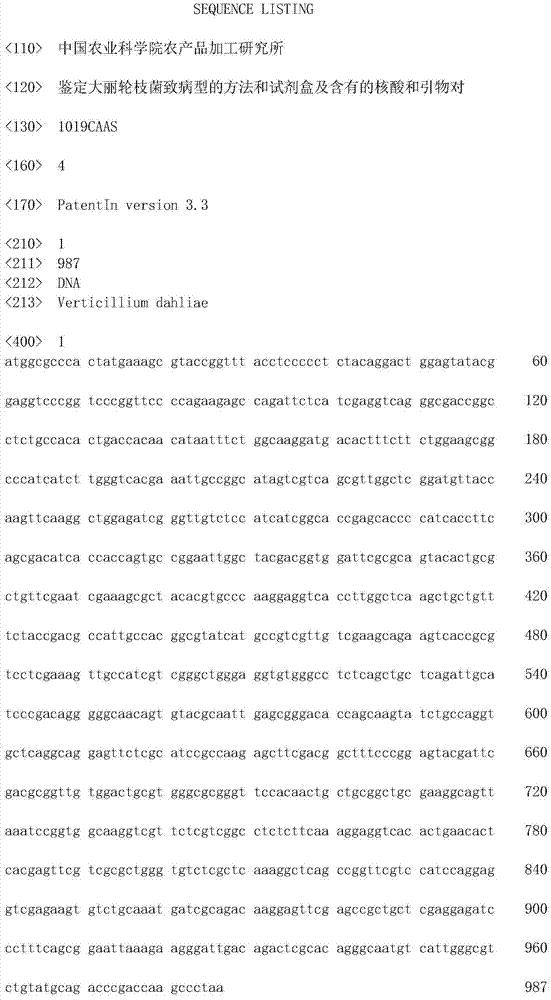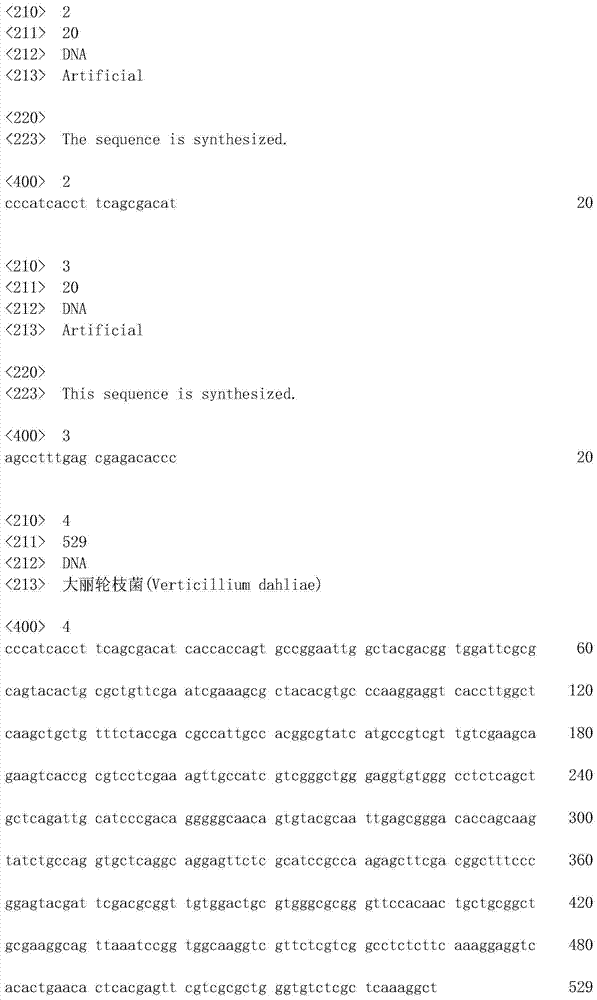Method for identifying pathotype of verticillium dahlia, kit and contained nucleic acid and primer pair
A technology of Verticillium dahliae and primer pairs is applied in the field of identifying pathogenic types of fungal strains and kits, and can solve the problems of farmland yield of severe cotton diseases, large differences in pathogenic types, and farmland yield of mild cotton diseases.
- Summary
- Abstract
- Description
- Claims
- Application Information
AI Technical Summary
Problems solved by technology
Method used
Image
Examples
Embodiment 1
[0022] This example is used to illustrate the preparation of samples to be tested. Specifically, genomic DNA was prepared from 80 different Verticillium dahliae strains (numbered VDG1 to VDG80).
[0023] Cut the stem of the cotton plant about 10-35cm above the ground and cut it into 1mm 3 Small pieces of about the size are inoculated in PDA medium (containing 200 g / L of potato, 20 g / L of glucose, and 20 g / L of agar) containing antibiotics (ampicillin, rifampicin and streptomycin, all at a concentration of 100 μg / ml) Above, cultivated at 25°C for 7 days, and identified the colonies of Verticillium dahliae according to the standard colony morphology of Verticillium dahliae. The identified colonies of Verticillium dahliae were taken as samples of Verticillium dahliae strains.
[0024] According to the above method, 80 different Verticillium dahliae bacterial strains were obtained from 80 different cotton plants, and the above-mentioned 80 different Verticillium dahliae bacteria...
Embodiment 2
[0026] This example is used to illustrate the detection results of the pathogenic types of the above 80 different Verticillium dahliae strains.
[0027] Refer to literature (Zhu Heqin, Feng Zili, Li Zhifang, Zhao Lihong, Shi Yongqiang. Identification of Verticillium wilt resistance of cotton varieties (lines) by quantitative dipping in vermiculite sandy bottomless paper bowl. China Cotton, 2010, 37(12) : 15-17) in the vermiculite sandy soil bottomless paper pot quantitatively dipped in bacterial solution method, the 80 different Verticillium dahliae strains described in Example 1 were carried out to identify the pathogenic type of cotton seedlings. The level of the pathogenic type was characterized by the disease index of the 80 different Verticillium dahliae strains after inoculating healthy cotton plants.
[0028] Specifically, Verticillium dahliae was cultured in Chapic medium (2g / L NaNO 3 , K of 1g / L 2 HPO 4 , 0.5g / L KCl, 0.5g / L MgSO 4 , 0.01g / L FeSO 4 , 30g / L sucrose...
Embodiment 3
[0034] The whole genome sequence of Verticillium dahliae strains (numbered VDG1 and VDG2) was determined according to the method specified in the instruction manual (Solexa technology) of Genome Analyzer of Illumina Company.
[0035] In this example, the whole genome sequences of the above two different Verticillium dahliae strains were obtained. Through sequence comparison, it was identified that the whole genome sequence of VDG1 does not contain the sequence shown in SEQ ID NO: 1; while the whole genome sequence of VDG2 The genome sequence contains the sequence shown in SEQ ID NO:1.
[0036] By the same method as above, 61 of the above 80 different Verticillium dahliae strains (respectively VDG3, VDG63, VDG61, VDG18, VDG35, VDG32, VDG73, VDG31, VDG33, VDG26, VDG55, VDG23, VDG57, VDG36, VDG11, VDG67, VDG47, VDG5, VDG29, VDG59, VDG49, VDG44, VDG21, VDG48, VDG8, VDG50, VDG25, VDG43, VDG37, VDG46, VDG16, VDG4, VDG4, VDG38, VDG2 VDG45, VDG12, VDG76, VDG27, VDG10, VDG41, VDG64, V...
PUM
 Login to View More
Login to View More Abstract
Description
Claims
Application Information
 Login to View More
Login to View More - R&D
- Intellectual Property
- Life Sciences
- Materials
- Tech Scout
- Unparalleled Data Quality
- Higher Quality Content
- 60% Fewer Hallucinations
Browse by: Latest US Patents, China's latest patents, Technical Efficacy Thesaurus, Application Domain, Technology Topic, Popular Technical Reports.
© 2025 PatSnap. All rights reserved.Legal|Privacy policy|Modern Slavery Act Transparency Statement|Sitemap|About US| Contact US: help@patsnap.com



